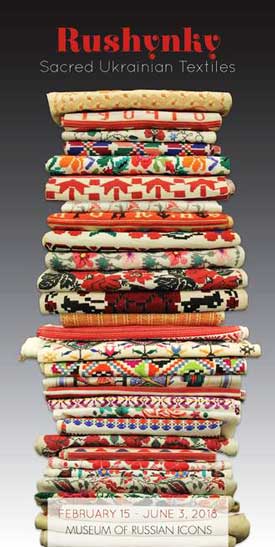Press release submitted by the Museum of Russion Icons
The Museum of Russian Icons presents Rushnyky: Sacred Ukrainian Textiles, an exhibition celebrating and exploring Ukrainian culture through one of its most ancient and valued traditions. Rushnyky are ornately embroidered woven textiles that function at the core of many life-cycle ceremonies and rituals of the Ukrainian people. On view February 15 to June 10, 2018, the exhibition will feature more than 80 rushnyky, Ukrainian icons, and related artifacts.

A rushnyk is a long rectangular cloth, typically handwoven in one solid piece from white linen or hemp, measuring 6-8 feet long by 1-2 feet wide. Often adorned with brightly colored patterns, the symbolic decoration preserves archaic magical signs, symbolic colors and motifs, as well as Slavic artistic folk styles. Some cloths are decorated with intricate white-on-white satin stitch, cutwork, lace, and drawn thread work embroidery. Rushnyk have distinctive regional characteristics. For example, in central Ukraine, cloths typically feature the tree of life surrounded by animal, bird, and floral motifs.
Steeped in tradition and faith, the shape of the rushnyk represents life’s journey, and the cloths are believed to be a median between the secular and the divine. The process of spinning thread and weaving linen embodies spiritual power reflecting the ancient deity Mokosh, often represented in embroidery. The needle has its own energy (similar to the chi of acupuncture), and the color of the thread has sacred meaning. Red represents life and is the main color used.
The word rushnyk (singular; plural rushynky) derives from ruka, the Russian word for hand. Traditionally made at home by women who start learning to spin, weave, and embroider the cloths at a very young age; today most rushnyky are machine made using modern materials, and can be purchased in retail establishments.
Capturing the cultural and ancestral memory of the region, the textiles play an important role during major ritual events in the life of Ukrainians, such as christenings, funerals, and especially weddings. Icons hung in homes are usually draped with a rushnyky; and they are also used during certain seasonal and religious holidays.
Rushnyky have many uses. The most basic type, colloquially called an utyralnyk or wiper, serves as a towel. In contrast, a nabozhnyk is a highly decorated rushnyk comprising embroidery and lace that decorate icons and icon corners in homes. Rushnyky are ritual objects used in ceremonies from birth to death. Newborns are immediately laid on a rushnyk; intricate wedding formalities utilize several rushnyky; coffins are sometimes lowered into the ground with rushnyky; and gravesites and holy shrines can be festooned with the textiles. Rushnyky are also widely used as home décor and for everyday practical needs.
The exhibition is curated by Franklin Sciacca, Associate Professor of Russian Language and Literature at Hamilton College in NY, who in talking about the impetus for his collection, recalls, “Some years ago my interest in Ukrainian and Russian ritual towels was kindled by a family legend recounted to me in my grandmother’s village of Bazaliya in Ukraine. I am an American because some 100 years ago my grandmother, Olyana Onyshchuk, engaged in a binding ritual with a young man. The betrothal ritual [zaruchennia] was a ceremonial step taken to solidify the promise to marry between the two parties. The hands of the young couple and their parents were bound together with a rushnyk by one of the matchmakers, who then pronounced, ‘I’m not tying a knot, I’m tying your word.’”
“The young couple knelt on a ritual cloth and were blessed by the parents, after which gifts of various textiles were exchanged as a sign of the uniting of the couple and the two families. The transaction was the equivalent of a marriage vow and solemnized a formal engagement to be married. My grandmother’s subsequent breaking off the engagement led to a scandal not only for herself, but her entire family—which they remember (with both a laugh and a sigh) to this day. The stigma attached to her refusal could only be remedied by her escaping the village, so she decided to come to America, not for religious freedom or out of desperate economic need, but because of the ritual exchange of rushnyky!”
RELATED EVENT
Rushnyky Exhibition Opening Reception
Thursday, February 15, 6 to 8 p.m.
Members Free, Nonmembers $15
Join us to mark the opening of the new special exhibition, Rushnyky: Sacred Ukrainian Textiles.
Franklin Sciacca, owner of the collection and curator of the exhibition, will talk about the rushnyk as artifact–its construction, regional variations, and functions as a ritual talisman in life transitions.
Rushnyky are ornamented textiles (sometimes referred to as “ritual towels”) that function at the core of many life-cycle ceremonies of the Ukrainian people. The presentation will explore the rushnyk as artifact–its basic construction as well as regional types and variations–with special focus on the function of these cloths as binding amulets and magical talismans, particularly in wedding and funeral rituals.
ABOUT THE MUSEUM
The Museum of Russian Icons inspires the appreciation and study of Russian culture by collecting and exhibiting icons and related objects; igniting the interest of national and international audiences; and offering interactive educational programs. The Museum serves as a leading center for research and scholarship through the Center for Icon Studies and other institutional collaborations. It is the only museum in the US dedicated to Russian icons, and is the largest collection of icons outside of Russia.
Museum hours: Tuesday to Friday, 11 a.m. to 4 p.m., first Thursday of the month to 8 p.m., Saturday and Sunday 11 a.m. to 5 p.m., closed Mondays.
Admission: Adults $10, Seniors (59+) $7, Students $5, Children (3-7) $5, Children under 3 Free.
For more information please visit museumofrussianicons.org.